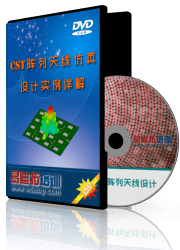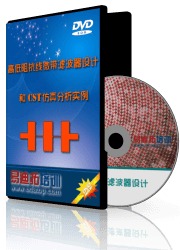- 易迪拓培训,专注于微波、射频、天线设计工程师的培养
CST2013: Material Parameters: default - Conductivity
Modeling: Materials New/Edit
New/Edit New Material
New Material Conductivity
Conductivity
Edit Object Properties  (navigation tree: Materials:material1
(navigation tree: Materials:material1 Properties
Properties Conductivity)
Conductivity)
This is a dialog page of the Material Parameters dialog box. It is only visible for "Default" and "High Frequency" material sets.
On this dialog page, the electric and magnetic conductivity characteristic of the current material may be specified. This is possible by defining either the conductivity value or the tangent delta value of the material. For dielectric losses, special tangent delta models are offered to enable a realistic material modeling. All input parameters are also available for an anisotropic material type.
Note that it is not possible to define a conductivity or tangent delta value for a previously defined dispersive material.
The introduction of losses leads to complex material parameters possessing both a real and an imaginary part. For all possible loss definitions on this page, the real part is always determined by the permittivity or the permeability value, respectively, on the Material Parameter - General page. If the real part of the complex material model is frequency dependent, the defined value is only correct for one frequency point, namely the specified tangent delta frequency (constant fit) or the solver center frequency (dispersion fit).
Note: Defining parameters for constant electric/magnetic conductivity value then they can be used with sensitivity analysis (see Sensitivity Analysis for more information).
Electric conductivity frame
Electric conductivity: Activating this radio button defines a conducting material based on the model of a constant electric conductivity value.
Nonlinear: This checkbox enables setting of the nonlinear electric conductivity. Button Properties... opens the Nonlinear Electric Conductivity dialog, where the E(J)-curve can be defined.
Tangent delta electric: Activating this radio button offers the possibility to define different loss models based on electric tangent delta values.
Specification: Three different electric tangent delta specifications are available:
Const. Conductivity: This model corresponds to a material possessing a constant conductivity as mentioned above, but is defined by the input of an electric tangent delta value given at a specific frequency.
Const. fit tan delta: This specification is based on a pole-zero dispersion model, defined again by the input of an electric tangent delta value given at the defined frequency and by the model order. The first order corresponds to a Debye dispersion whereas higher order models are specifically developed to fit a broadband constant imaginary part of the permittivity. They are particularly suitable for low losses (low tangent delta value) materials. As mentioned above, at this frequency point the real part of the permittivity equals the epsilon input on the Material Parameter - General page. Please note that a perfectly constant tangent delta does not exist in reality; however, the broadband behavior of this formulation represents an almost constant tangent delta curve.
Dispersion fit tan delta: The dispersion fit is based either on a constant conductivity or a General 1st order model. Now more than one tangent delta value may be defined for different frequency points by pressing the Dispersion List… button. To each frequency point a weight is assigned in order to direct the interpolation algorithm and to enforce the result quality. Again, the real part of the permittivity is given by the epsilon input on the Material Parameter - General page. Please note that due to the frequency dependent material behavior the values correspond only at the center frequency.
Magnetic conductivity frame
Magnetic conductivity: Activating this radio button defines a conducting material based on the model of a constant magnetic conductivity value.
Tangent delta magnetic: Activating this radio button enables the input of a magnetic tangent delta value given at specific frequency.
Specification: Three different magnetic tangent delta specifications are available:
Const. Conductivity: This model corresponds to a material possessing a constant conductivity as mentioned above, but is defined by the input of a magnetic tangent delta value given at a specific frequency.
Const. fit tan delta: This specification is based on a pole-zero dispersion model, defined again by the input of a magnetic tangent delta value given at the defined frequency and by the model order. The first order corresponds to a Debye dispersion whereas higher order models are specifically developed to fit a broadband constant imaginary part of the permeability. They are particularly suitable for low losses (low tangent delta value) materials. As mentioned above, at this frequency point the real part of the permeability equals the mue input on the Material Parameter - General page. Please note that a perfectly constant tangent delta does not exist in reality, however, the broadband behavior of this formulation represents an almost constant tangent delta curve.
Dispersion fit tan delta: The dispersion fit is based either on a constant conductivity or a general 1st order model. Now more than one tangent delta value may be defined for different frequency points by pressing the Dispersion List… button. To each frequency point a weight is assigned in order to direct the interpolation algorithm and to enforce the result quality. Again the real part of the permeability is given by the mue input on the Material Parameter - General page. Please note that due to the frequency dependent material behavior the values correspond only at the center frequency.
Frequency range frame
Fmin/Fmax: These text fields are for information purposes only. They show you the minimal and maximal chosen frequency. To change these values you may go into the frequency range settings in the main menu under Solver Frequency....
Frequency....
CST微波工作室培训课程套装,专家讲解,视频教学,帮助您快速学习掌握CST设计应用
上一篇:CST2013: Import Material Curve
下一篇:CST2013: Temperature Dependent Materials
CST涓枃瑙嗛鍩硅鏁欑▼ | More...
 最全面、最专业的CST微波工作室视频培训课程,可以帮助您从零开始,全面系统学习CST的设计应用【More..】
最全面、最专业的CST微波工作室视频培训课程,可以帮助您从零开始,全面系统学习CST的设计应用【More..】
频道总排行
- CST2013: Mesh Problem Handling
- CST2013: Field Source Overview
- CST2013: Discrete Port Overview
- CST2013: Sources and Boundary C
- CST2013: Multipin Port Overview
- CST2013: Farfield Overview
- CST2013: Waveguide Port
- CST2013: Frequency Domain Solver
- CST2013: Import ODB++ Files
- CST2013: Settings for Floquet B










